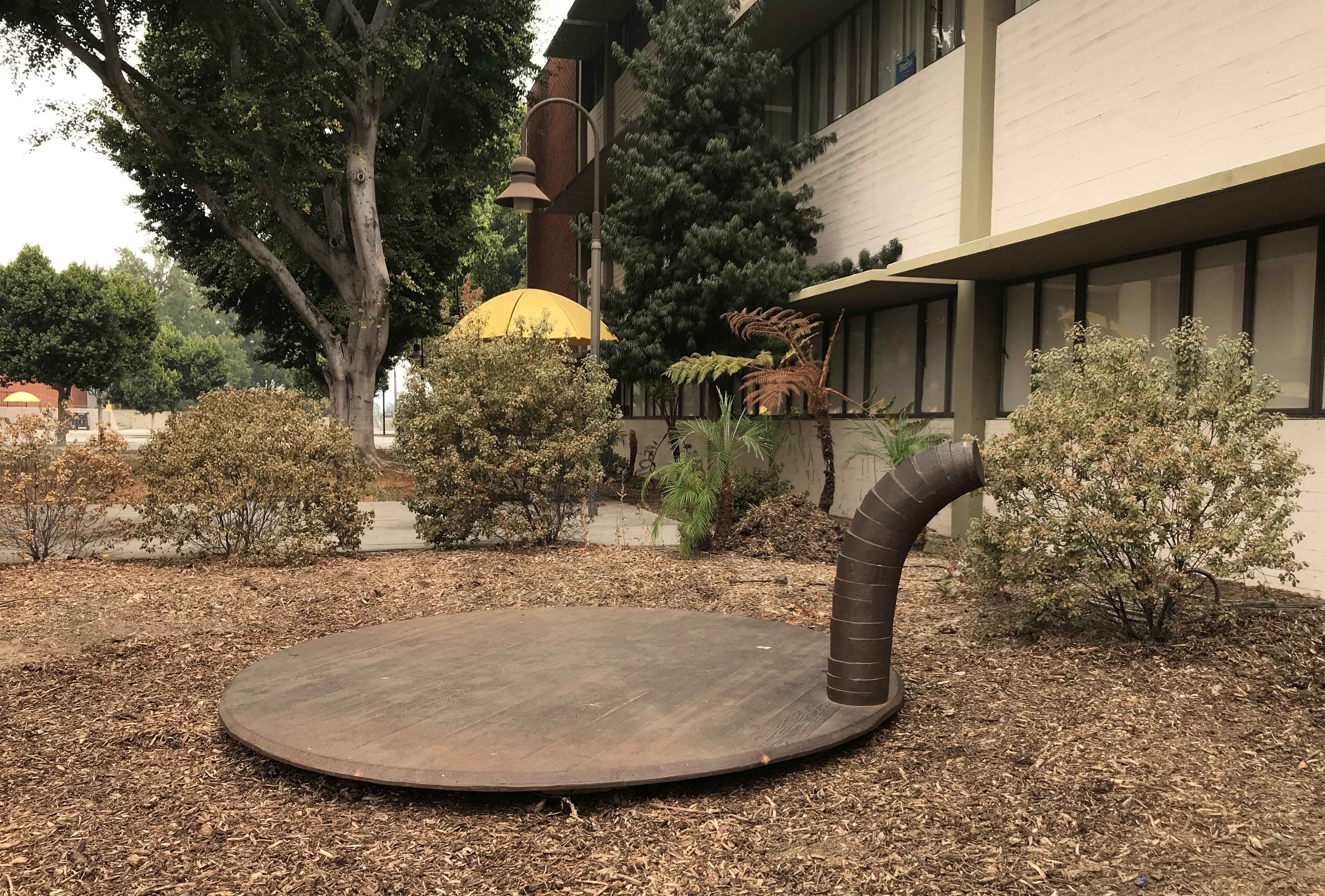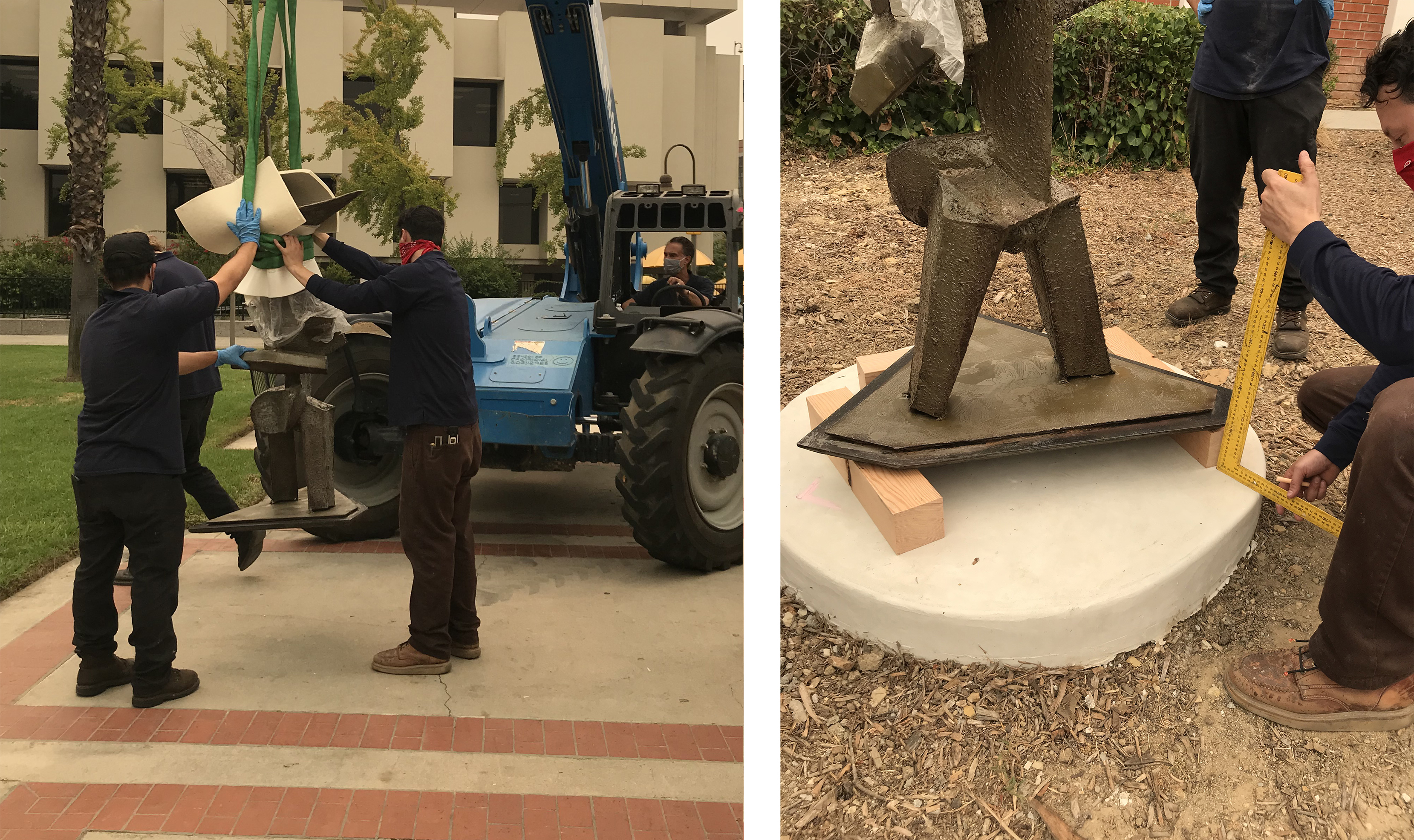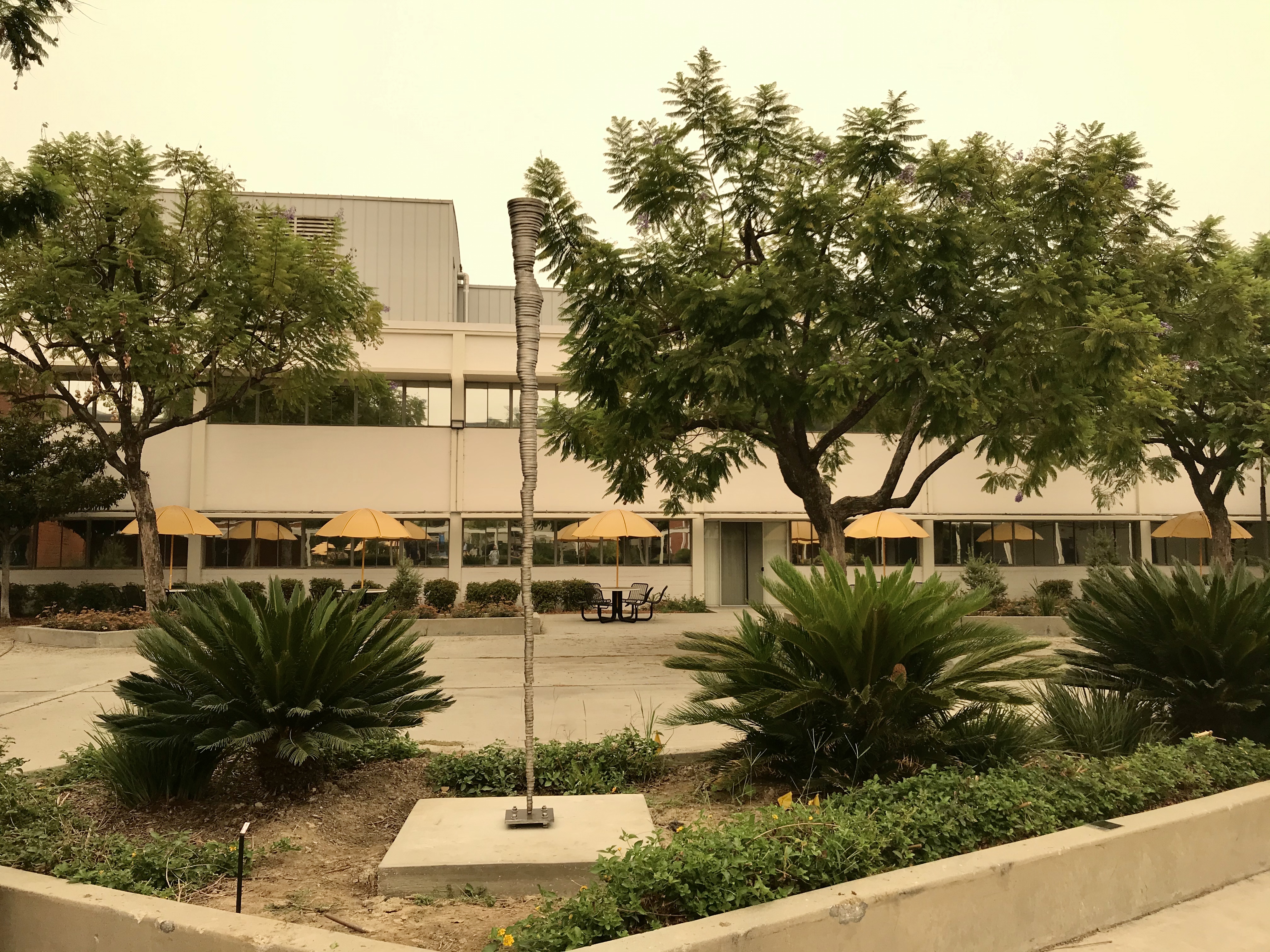Csu La Two Statues or Other Pieces of Public Art
Installation photograph, featuring Bernard Zimmerman's John Henry (1957), at California State University, Los Angeles, September 2020, Los Angeles County Museum of Art, gift of Rose Barlow, © Bernard Zimmerman
Three Sculptures Installed at California State University, Los Angeles
It had been six months since LACMA, forth with the rest of the country, shut down all not-essential operations to keep staff and visitors prophylactic from COVID-nineteen. By September 10, 2020, when nosotros gathered on the quiet grounds of California State Academy, Los Angeles, information technology had been the longest stretch in almost of the team's professional lives without installing art. Thanks to the perseverance, safety protocols, and the unwavering excitement of Dr. Linda Essig, Dean of the Higher of Arts and Letters at Cal State LA, and her dedicated group of engineers, facilities, and operations team members, nosotros were able to terminate that unfortunate stretch of time away from art-in-real-life. This re-entry was particularly meaningful not just considering we were able to replenish our souls with that intangible something that we, equally fine art professionals, count on regularly—a connection to creation, reflection, beauty—but too because we were able to restart LACMA's ongoing plan to share art in public settings around L.A. Canton.
As part of LACMA'south commitment to engaging the varied communities beyond our campus at Wilshire Boulevard, over the past several years nosotros have lent some of our big outdoor sculptures to sites across L.A. County where art is not traditionally displayed. Equally part of this initiative thus far, nosotros take placed 13 sculptures on long-term loan, many of which have never been on view before. In a collaborative process involving the borrowing institution and our team at LACMA, each sculpture is advisedly selected to match the unique settings of its final destination, in terms of scope, scale, and field of study.
At Cal State LA, we drew on the university's commitments to providing an fantabulous pedagogy and nurturing their students into strong customs partners to cull artwork appropriate to the educatee population and to the public who use the open up campus. For this jewel of the public university arrangement, which is "defended to date, service, and the public good," Cal State LA and LACMA together decided on iii works of fine art that would reverberate their goals: Martin Puryear'due south Decoy from 1990, Bernard Zimmerman'southward John Henry from 1957, and Marking Lere'south Tornado from 1985.

Installation photo, featuring Martin Puryear's Decoy, 1990, at California State University, Los Angeles, September 2020, Los Angeles County Museum of Art, purchased with funds provided by the Art Museum Council and the Flintridge Foundation, 1991, © Martin Puryear
Martin Puryear is a celebrated contemporary creative person deeply committed to exploring his craft. While he is often considered a minimalist, he maintains that the course and materials of his piece of work inevitably tell a story. Race, identity, and ritual, in improver to biography, are often at the cadre of his work, and Decoy, is role of a series that explores stereotypes and the deceptive identities they conjure. Its graceful vertical course provides balance to the weighty circumvolve on the basis, and Puryear's reductive forms can be intensely evocative despite their elemental nature. The only other time this work left LACMA since its acquisition in 1991 was for an exhibition at the White House on contemporary American sculptors in 1995–96.

Installing Bernard Zimmerman'south John Henry (1957), at California Country University, Los Angeles, September 2020, Los Angeles County Museum of Art, gift of Rose Barlow, © Bernard Zimmerman
An creative person and instructor in Southern California during the 2nd half of the 20th century, Bernard Zimmerman began his formal education at the Otis Art Institute before becoming an art teacher. During that time he exhibited widely in the region, and made several pregnant public architectural commissions in and around Los Angeles during the late 1950s into the 1960s. His big-scale sculpture was made of welded metal and bandage bronze, and Zimmerman was defended to using reductive geometric forms to sculpt. This abstracted interpretation of the African American folk hero John Henry, who was appropriated by the labor movements of the 1950s and 60s equally well equally the Civil Rights movement, is a pronouncement of Zimmerman'south political and artistic interests. John Henry stands as a progressive keepsake amid political turmoil and social unrest. In both discipline and fashion, Zimmerman's sculpture represents the creative and curatorial voices working in less traditional modes that battled against deeply conservative local authorities in the post-war period.

Installation photograph, featuring Mark Lere's Tornado (1985), at California Country University, Los Angeles, September 2020, Los Angeles Canton Museum of Fine art, gift of Joyce Hunsaker, © Marking Lere
Marking Lere is an 50.A.-based artist who has for years harnessed the possibilities of abstruse forms in service of exploring a stiff interest in the natural earth. During the 1980s, drawn from his experience growing up in North Dakota, he focused more firmly on environmental phenomena, including the forces of water and wind. He has used a diversity of materials, some water based (plaster, physical), and some forged (bronze, steel), equally in his "Vortices," of which Tornado is one example. A unmarried columnar totem made of steel discs stacked over viii feet high, the hardened, smooth material is a deliberate contrast with the unpredictability of nature. Lere'southward emphasis on his sculpture's relationship to space is a trademark of his work.
Together we hope these three works of art provide respite in a stressful time, as they did for our teams, whose spirits were reinvigorated by our proximity to art after several months in quarantine. More importantly, as we look forrad, we hope the sculptures allow for a moment of reflection or inspiration, or better even so, provide a space to gather together, when students are back buzzing around, heads down, running from grade to class, after life returns to normal.
Source: https://unframed.lacma.org/2021/01/11/three-sculptures-installed-california-state-university-los-angeles
0 Response to "Csu La Two Statues or Other Pieces of Public Art"
Postar um comentário